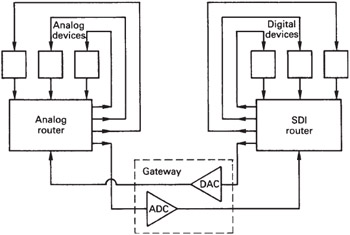8.2 Timing in Digital Installations
| | ||
| | ||
| | ||
8.2 Timing in Digital Installations
The issue of signal timing has always been critical in analog video, but the adoption of digital routing relaxes the requirements considerably. Analog vision mixers need to be fed by equal length cables from the router to prevent propagation delay variation. In the digital domain this is no longer an issue as delay is easily obtained and each input of a digital vision mixer can have its own local timebase corrector. Provided signals are received having timing within the window of the inputs, all inputs are retimed to the same phase within the mixer.
Figure 8.2 shows how a mixing suite can be timed to a large SDI router. Signals to the router are phased so that the router output is aligned to station reference within a microsecond or so. The delay in the router may vary with its configuration but only by a few microseconds. The mixer reference is set with respect to station reference so that local signals arrive towards the beginning of the input windows and signals from the router (which, having come farther, will be the latest) arrive towards the end of the windows . Thus all sources can be retimed within the mixer and any signal can be mixed with any other. Clearly the mixer introduces delay, and the signal feedback to the router experiences further delay. In order to send the mix back to the router a frame synchronizer is needed on the output of the suite. This introduces somewhat less than a frame of delay so that by the time the signal has re-emerged from the router it is aligned to station reference once more, but a frame late. An installation of this kind relies on a gen- lockable sync pulse generator having multiple outputs with independent phase control.

Figure 8.2: In large systems some care is necessary with signal timing as is shown here. See text for details.
In an ideal world, every piece of hardware in the station would have component SDI outputs and inputs, and everything would be connected by SDI cable. In practice, unless the building is new, this is unlikely . However, there are ways in which SDI can be phased in alongside analog systems. An expensive way of doing this is to fit every composite device with coders and decoders, and every analog device with convertors so that a component SDI router can be used alone. Figure 8.3 shows an alternative. The SDI router is connected to every piece of digital equipment. Analog equipment continues to be connected to an analog router, and interconnection paths, called gateways, are created between the two routers. These gateways require convertors in each direction, but the number of convertors is much less than if every analog device was equipped. The number of gateways will be determined by the number of simultaneous transactions between analog and digital domains.

Figure 8.3: Digital routers can operate alongside existing analog routers as an economical means of introducing digital routing.
In many cases the two routers can be made to appear like one large router if appropriate software is available in a common control system. This will only be possible if the SDI router is purchased from the same manufacturer as the existing analog router or if the SDI router manufacturer offers custom software.
Whilst modern DVTRs incorporate the audio data in the SDI signal, adapting older devices to do this and subsequently demultiplexing the audio could prove expensive. DVTRs tend also to be inflexible in their audio selection. For example, it may not be possible to record certain audio channels from embedded SDI data at the same time as other channels from the AES/EBU inputs. Also the embedded audio may not contain timecode even though the standard allows it. As a result in some installations it may be more appropriate to retain an earlier audio router, or to have a separate AES/EBU digital audio router layer controlled in parallel with the SDI router.
If the analog router handles composite signals, then coders and decoders will be needed in addition to the convertors. In this case the use of gateways obviates unnecessary codecs when analog devices are connected together.
| | ||
| | ||
| | ||
EAN: 2147483647
Pages: 120